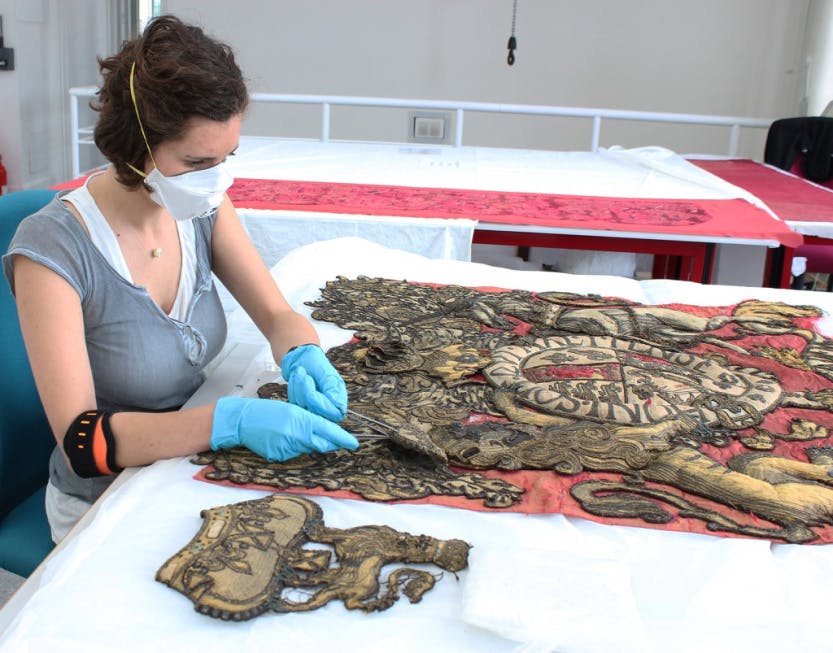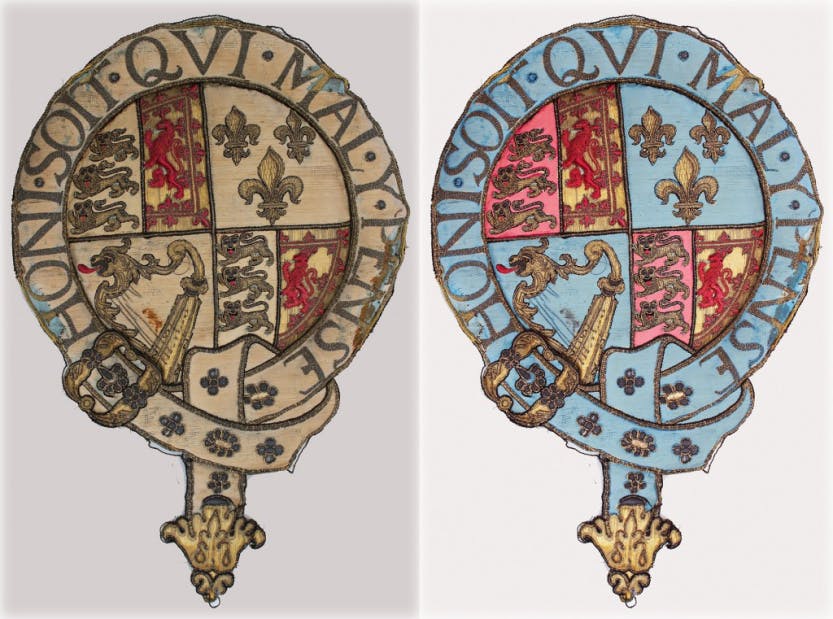Progress on the Coat of Arms
Queen Anne's Throne Canopy Conservation
Date: 18 October 2016
Author:
Viola Nicastro
At first glance, the coat of arms embroidery appears to be one whole piece. It is however made up of 19 individual pieces, put together like a puzzle. The picture of the unicorn below shows that it is in fact made of four different sections.
We had two options: treat the embroidery as one whole piece or separate them and conserve them individually. As with other parts of the project we had to weigh up the ethics of dismantling the original textile against its conservation needs and in this instance we decided to separate the pieces.
Before proceeding, we took detailed photographs and accurately recorded the position of each element – these steps are essential to ensure we put everything back together in its original location and make no changes to the nature of the throne canopy.
Separating the embroidery from the backcloth has certainly been exciting and we have discovered many hidden details. We were fascinated to see the medley of materials used for padding to give a three dimensional shape; as if the craftsmen had used whatever scraps were available on the workshop floor. We identified a total of six materials here: linen, paper, wood, wool, felt and vegetable fibres. A thrifty way to save money when no one expected it ever to be uncovered!
The front did not disappoint either and revealed more hidden details. The shield today is a soft creamy colour, but that is not its original appearance: in the few small sections where the unicorn and lion overlap it has been protected from the light damage and oxidation suffered by the rest of the shield. We were excited to see that it would have been bright blue and gold when new.
Inside the shield, we found red satin, now faded to a dull cream where it was exposed. We have digitally reconstructed the original appearance to show how the shield would have once looked. All the dark threads you see in the image are now tarnished but when new they would have been glittering metal and one can only imagine how regal it would have looked.
In our next post: find out how the throne canopy will be hung…
Viola Nicastro
Textile Conservator
Acquired with the assistance of the Art Fund. Conserved with assistance from Lord Barnby’s Foundation, Idlewild Trust, The Radcliffe Trust, The Leche trust, Broadley Charitable Trust and the Worshipful Company of Tin Plate Workers alias Wire Workers. We are grateful for their support.
More from our blog

Queen Anne's Throne Canopy Conservation: Almost There!
27 September 2017
These past few months we've been busy finishing the Queen Anne throne canopy conservation; tying together all the loose ends ready for its display at Kensington Palace.

'The new Terrors of Death': Dr John Arbuthnot, Queen Anne’s favourite physician
11 March 2024
Dr John Arbuthnot was among the army of medical specialists who were summonsed to serve the Royal family in the 18th century. Arbuthnot is little remembered today, but he was 'the Queen’s favourite physician' — a gentle-mannered confidante to courtiers, politicians, poets, writers and ladies-in-waiting alike.

Conservation of an 18th century headboard: Secrets of a State Bed
13 March 2020
As part of our Secrets of a State Bed series, Conservator Viola Nicastro explains the process of conserving the headboard of Queen Caroline's State Bed, and reveals more of its secrets.





